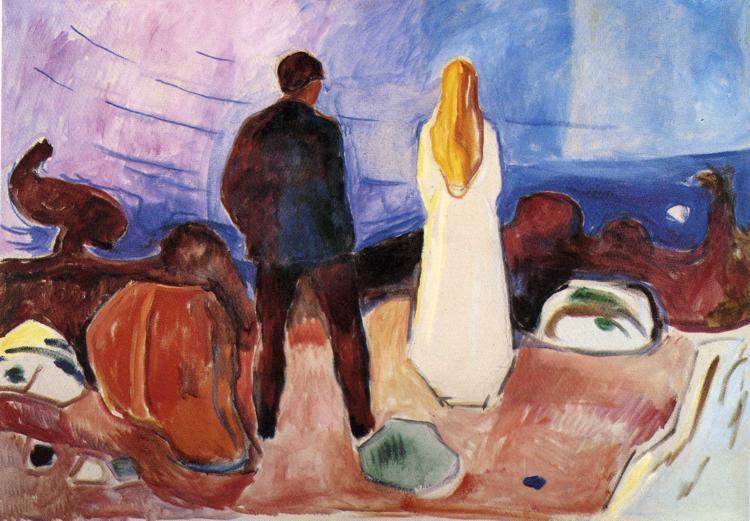Description
Edvard Munch, central figure of symbolism and precursor to expressionism, has left an indelible mark on art history through its disturbing translations of human experience. His work "Los Solitarios" (1935) masterfully encapsulates the feeling of isolation and melancholy that pervade his career. On this canvas, Munch invites us to explore the complexity of loneliness, a recurring theme in its production, at the same time reflecting his personal struggles and a deep understanding of the human condition.
From a first look, the composition of "Los Solitarios" is presented in a gloomy context, where the central figure becomes the emotional focus of the piece. The painting is dominated by an atmosphere that evokes introspection and restlessness. Munch uses an almost sculptural use of the form, emphasizing the contours of the characters that populate the painting. The figure in the foreground, on his back, seems mired in his thoughts, representing the anguish and disconnect of the world around him. In its isolation, a reflection on identity and alienation arises, an aspect that Munch has treated in several works throughout his life.
The tones used in "lonely" are predominantly dark, with a palette that attracts to nuances of deep, gray and black blue, which add an additional layer of sadness and longing. The colors, far from being merely decorative, function as their own language that resonates with the feelings evoked by the figures. Subtle contrasts and tonal transitions accentuate the atmosphere of melancholy, highlighting the internal struggle that reflects the work of the artist.
The characters, although they do not present explicitly or individualized, are groups that seem to be trapped in their own realities, exposed to an environment that embraces them but, at the same time, keeps them distant. This connection and disconnection dilemma is a leitmotiv in Munch's work. The relationship between the figures, arranged in different planes of the painting, It suggests an implicit dialogue at the time critic of contemporary loneliness, capable of resonating with the viewer, who faces his own isolation history.
Munch had experienced with symbolism in his previous work, and "lonely" stands as a continuation of his aesthetic and psychological concerns. This work can also be seen in the context of its works as "the cry" or "La Madonna", where the emotional impact is central to the experience of the one who observes. The influence of symbolism and expressionism is highlighted not only in the way Munch portrays his themes, but also in his ability to evoke a visceral response through his color and shape choices.
As the works of Edvard Munch are examined, "Los lonelios" is presented as a powerful reminder of the individual's struggle in the search for connection in a world that often feels inhospitable and cold. The work radiates a sense of emotional urgency, offering an experience that invites contemplation, and reaffirming Munch as an artist deeply aware of human fragility. In this piece, not only the artist's essence is encapsulated, but a timeless reflection on loneliness that continues to resonate today.
KUADROS ©, a famous paint on your wall.
Hand-made oil painting reproductions, with the quality of professional artists and the distinctive seal of KUADROS ©.
Art reproduction service with satisfaction guarantee. If you are not completely satisfied with the replica of your painting, we refund your money 100%.

